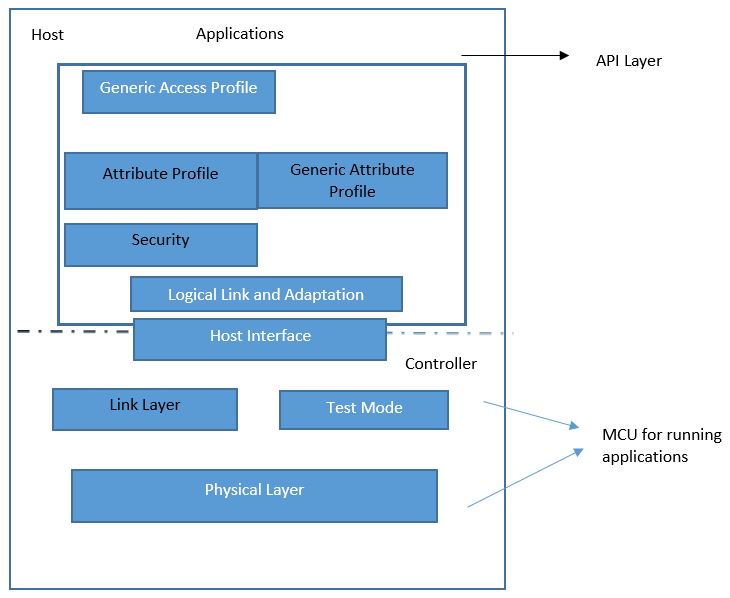- Home
- Symmetry Blog
- A Bluetooth Low Energy Application: Defining the BLE Stack
A Bluetooth Low Energy Application: Defining the BLE Stack
Tuesday, December 9, 2014
Bluetooth Low Energy (BLE) is one of the world’s hottest applications as the world of wireless is exploding. BLE has entered the market with new features and expanded operations. Applications possibilities for BLE are nearly limitless.
BLE is designed for new emerging applications and markets, but it still embraces the very same benefits we already know from the classic, well established Bluetooth technology.
Adaptive frequency hopping used in BLE will allow for fast hops within a much wider frequency band. This will reduce interference and allow identification of close frequencies and filter them out. Broadcasting BLE is connection oriented and provides a very secure and reliable method of transmitting data.
Security, privacy, and data integrity are always issues in a wireless network running critical applications. BLE technology was created to include higher levels of security than Classic BT, including authentication, authorization, and 128bit encryption.
BLE technology is an open standard specified and developed by the Bluetooth Special Interest Group (SIG). Based on the license free 2.4GHz frequency band, BLE technology can be used in worldwide applications. These allow wireless device manufacturers to develop interoperable solutions so equipment will communicate with all devices regardless of vendor.
There are two modes of Bluetooth 4.0 devices:
Single mode devices only support Bluetooth Low Energy and are optimized for low-power, low-cost, and small size solutions. Dual mode devices support BLE and classic Bluetooth technologies which can interoperate with existing and new Bluetooth specifications.
Key features of BLE wireless technology include:
- Ultra-low peak, average, standby mode power usage
- Ability to run for years on standard, coin-cell batteries
- Very low cost
- Multi-vendor interoperability
- Enhanced transmit range and receiver sensitivity
Below is a block diagram of the basic structure of a typical BLE stack.

Let’s define each block:
The Generic Access Profile (GAP) is the layer or protocol that defines how to discover and connect services to a Bluetooth device. GAP also is involved with security.
The Generic Attribute Profile (GATT) is a service protocol that defines the attributes and services of a BLE device. When the profile is setup by GAP the attributes assigned are to a particular service.
The Attribute Protocol (ATT) is a relatively new way of communication, as Bluetooth 4.0 (BLE) which handles smaller packets, is an enhanced method for BLE. Attributes are read for a server and those values can be used by the specific client. They can be in discovery, read from, and written to. The ATT works with the GATT to assist in managing the data size between devices, which ultimately reflects on controlling power.
The Security Manager (SM) is used for device pairing, or the method of listening to a BLE device and communicating with the other device. It does this by shifting functions from a slave device to a master. BLE uses 128AES encryption core which also provides device authentication.
The Logical Link and Adaptation (L2CAP) is a protocol that works in the background with GAP for the purpose of defining a set of rules for BLE device discovery and links to other low energy devices. It basically interweaves or multiplexes the different protocols and segments data into smaller chunks for the Link Layer and does the same at the other end by reassembling the data.
The Host Interface Controller (HCI), Link, and Physical Layers — HCI is the standard interface that interfaces with the stack. It can be an off the shelf MCU which runs the application. However, if both parts of the stack are embedded on the MCU, it is not necessary to have a HCI interface. For example, if a sensor app is embedded on the MCU, it is not required to have a separate HCI.
The Big Question: Single Mode or Dual Mode?
A common theme for designing a BLE application is whether or not to include classic Bluetooth. The first thing we can identify is the obvious: the stacks are different. You cannot run classic Bluetooth on a BLE stack, and the same hold true for the opposite. Dual mode stacks are therefore a requirement if the product needs to operate as a classic Bluetooth and needs the requirement of BLE. Examples of dual mode apps are:
- Remote Controls
- Wireless Speakers or/and Headsets
- Wireless Gateways
- Intercoms
For further information on BLE and classic Bluetooth, call Symmetry Electronics at (310 536-6190, or contact us online.